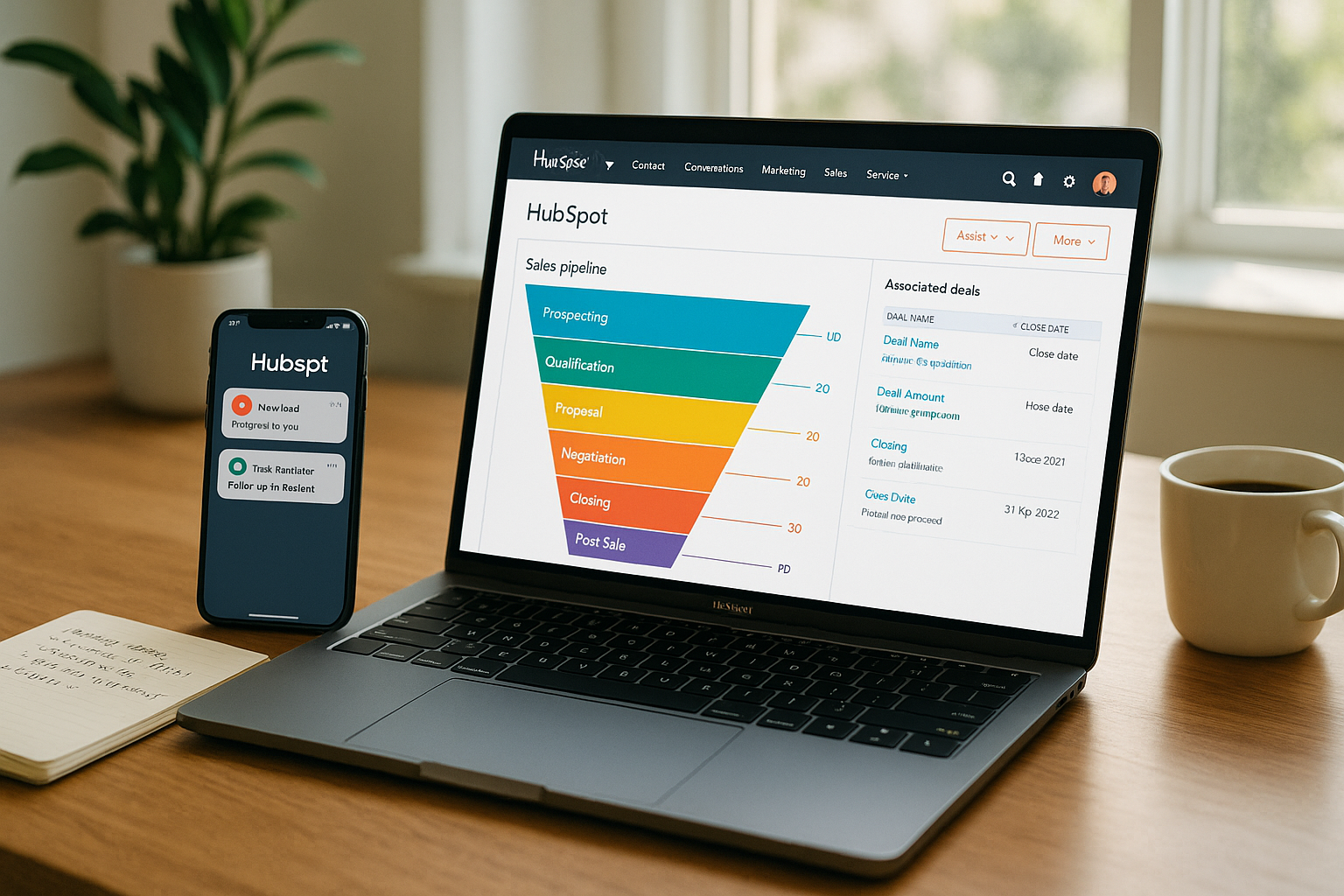Table of content:
What is a sales pipeline and how it supports growth
Why effective pipeline management matters in 2026
Main stages of a modern sales pipeline
Common issues in pipeline management and how to fix them
Overview of HubSpot’s pipeline features
Setting up your first sales pipeline in HubSpot
Tools in HubSpot that boost visibility and control
Using automation to simplify sales workflows
Monitoring pipeline health with real-time insights
Best practices for consistent pipeline improvement
How to avoid data overload in CRM systems
Making informed decisions with CRM analytics
Forecasting revenue through pipeline reporting
Enhancing collaboration with shared pipeline views
When and how to review your pipeline performance
Tips for scaling pipeline processes in growing teams
Innovations shaping pipeline management in the future
- How do I know if my pipeline is too full or too empty?
- What metrics should I track in my pipeline?
- How does HubSpot support business automation in 2026?
- How is AI shaping business strategies for 2026?
Effective Sales Pipeline Management in HubSpot CRM
Managing your sales pipeline effectively is essential for driving sustainable growth and achieving predictable revenue. Whether you lead a small startup or an established enterprise, understanding how to effectively manage a sales pipeline inside HubSpot CRM can transform how your team sells.
In this comprehensive guide, we’ll explore what makes great pipeline management in sales, how to build your first pipeline in HubSpot, and how to optimize it for maximum visibility, automation, and performance.
What Is a Sales Pipeline and How It Supports Growth?
Every business, regardless of size or industry, needs a structured way to track leads and deals. That’s where the sales pipeline comes in.
A sales pipeline represents your entire customer journey—from initial contact to deal closure. Each pipeline stage reflects a milestone in the buying process, helping your team measure progress, spot opportunities, and identify what actions to take next.
An optimized pipeline:
- Improves transparency across the sales cycle.
- Helps you calculate conversion rates between stages.
- Aligns day-to-day activities with long-term sales goals.
When businesses learn how to manage a sales pipeline effectively, they create a reliable framework for forecasting growth and improving accountability.
In short, a well-built pipeline doesn’t just organize deals—it fuels consistent progress and smarter decision-making.
Why Effective Pipeline Management Matters in 2026?
As sales environments become more data-driven, knowing how to manage sales pipeline efficiently is critical for staying competitive. In 2026, sales teams face complex buyer journeys, hybrid work setups, and increasing reliance on automation.
Effective pipeline management in sales ensures no lead is left behind. It helps teams prioritize high-value prospects, understand where deals are stalling, and make better use of time.
HubSpot CRM supports this evolution by offering unified data, AI-powered insights, and seamless automation—enabling companies to adapt to faster cycles and higher customer expectations.
When your pipeline is clean and structured, your team spends less time guessing and more time closing. That’s the power of smart, data-backed management in a modern sales world.
What Are the Main Stages of a Modern Sales Pipeline?
Building a strong pipeline starts with understanding its stages. Each pipeline stage reflects a specific point in the buyer’s decision process, giving structure and predictability to your operations.
Typical stages include:
- Prospecting—identifying potential customers.
- Qualification—verifying fit, interest, and buying intent.
- Proposal—presenting tailored solutions.
- Negotiation—aligning pricing, scope, and expectations.
- Closing—signing contracts and confirming deals.
- Post-Sale—delivering onboarding and nurturing long-term relationships.
Tracking conversion rates between these stages helps reveal bottlenecks and opportunities for improvement.
Remember—there’s no one-size-fits-all pipeline. The key is customizing it to your sales strategies so every stage serves a measurable purpose in driving growth.
Common Issues in Pipeline Management and How to Fix Them
Even well-designed pipelines can fail if not maintained properly. Common challenges include duplicate deals, lost leads, poor communication, and inaccurate data.
Some teams also struggle with manual updates or unclear ownership, which can make forecasting unreliable.
HubSpot resolves these issues through clear structure and automation. Custom sales tools like deal tracking, task reminders, and visual dashboards make it easier to stay organized and proactive.
To fix pipeline issues:
- Review and redefine each stage regularly.
- Train your team on proper deal handling.
- Use automation to log activity and reminders.
Effective pipeline management in sales depends not just on setup but on consistency—reviewing, cleaning, and improving your process over time.
Overview of HubSpot’s Pipeline Features

HubSpot’s CRM offers powerful sales tools that simplify pipeline control and visibility. Its features include customizable pipelines, automated workflows, and advanced reporting capabilities—everything your team needs to stay aligned and efficient.
Among the standout tools are:
- Drag-and-drop boards for quick deal updates.
- Custom fields to reflect your unique sales process.
- Deal scoring and tracking for prioritization.
- Built-in reporting to measure sales performance and pipeline health.
These capabilities give teams confidence and clarity when managing deals.
Understanding how to use CRM effectively means taking full advantage of HubSpot’s ecosystem—connecting data, people, and actions in one organized hub.
Setting Up Your First Sales Pipeline in HubSpot

Getting started with your first HubSpot pipeline is straightforward, even for beginners.
Here’s how:
- Go to Sales → Deals → Pipelines.
- Create or rename your pipeline.
- Define each pipeline stage based on your sales cycle.
- Assign properties like value, close date, and owner.
- Add automation for key transitions or alerts.
Once you’ve built your pipeline, test it with a few real deals to refine it.
Setting up properly at the start gives you a scalable foundation—one that helps you manage the sales pipeline effectively as your business grows.
Tools in HubSpot that Boost Visibility and Control
.webp?width=567&height=361&name=Customer%20Success%20Workspace%20(1).webp)
Visibility is the heart of good pipeline management. HubSpot provides numerous tools to make sure every deal, stage, and rep is on track.
Core visibility features include:
- Custom dashboards for tracking key metrics.
- Team-based filters for regional insights.
- Timeline views showing every contact interaction.
- Real-time progress toward sales goals.
These views help leaders spot trends, manage workload, and identify training opportunities.
By leveraging HubSpot’s dashboards, teams gain total control over pipeline management in sales, ensuring no opportunity slips through the cracks.
Using Automation to Simplify Sales Workflows
Automation is one of HubSpot’s greatest advantages. It minimizes repetitive work and increases productivity across all pipeline stages.
For example, you can:
- Automatically assign leads to reps.
- Trigger tasks when deals move stages.
- Send reminders for follow-ups.
- Update records based on conditions.
This automation shortens response times, keeps the pipeline clean, and improves deal velocity.
Learning how to manage a sales pipeline means embracing automation—not as a shortcut, but as a smart assistant that supports consistent sales performance.
Monitoring Pipeline Health with Real-Time Insights
Keeping a pulse on your pipeline is critical. HubSpot provides real-time dashboards showing active deals, average cycle length, and conversion rates across stages.
By monitoring these metrics daily or weekly, teams can adjust sales strategies quickly to meet their goals.
Healthy pipelines show balanced deal distribution and clear next steps. When metrics indicate stagnation, it’s time to act—assign ownership, revise messaging, or focus on high-probability deals.
The key is to treat these insights as a living feedback loop that guides improvement continuously.
Best Practices for Consistent Pipeline Improvement
No pipeline is perfect—improvement is ongoing.
Follow these best practices to enhance your pipeline:
- Audit deals weekly to remove stale entries.
- Compare conversion rates month-to-month.
- Set achievable sales goals tied to activity metrics.
- Use data to refine sales strategies and training.
HubSpot’s analytics make this process simple. Over time, small, consistent improvements compound into major performance gains—proving why continuous refinement is central to the efficient sales pipelines’ management.
How to Avoid Data Overload in CRM Systems
With so much information in modern CRMs, data overload is a real risk. When systems are cluttered, focus suffers, and valuable insights can easily get buried under unnecessary noise.
To avoid this:
- Keep only essential fields visible so teams see what truly matters at a glance.
- Segment contacts clearly by deal stage, source, or priority to streamline outreach.
- Clean and deduplicate data monthly to eliminate confusion and ensure accuracy.
- Use filters and saved views to highlight high-value opportunities and active deals.
A well-organized system makes it easier to use CRM effectively and ensures your team works smarter, not harder. It also improves user adoption, since a clean, intuitive workspace encourages consistent updates and better collaboration.
By keeping data clean, you preserve accuracy for sales forecasting and maintain a CRM your reps actually enjoy using. In the long run, a lean, structured database supports faster decisions, better customer relationships, and a more productive sales process.
Making Informed Decisions with CRM Analytics
HubSpot’s analytics go far beyond simple reporting—they provide actionable intelligence.
You can track:
- Deal velocity to understand how quickly opportunities move through stages.
- Stage progression to identify bottlenecks and optimize workflows.
- Individual sales performance to recognize top performers and pinpoint coaching needs.
- Pipeline efficiency to evaluate the overall health and balance of your funnel.
These insights guide everything from sales strategies to hiring decisions. By connecting performance data with business outcomes, leaders can see exactly what drives success—and where improvement is needed.
When teams understand which stages have the highest drop-off or where deals convert fastest, they can adjust processes to maximize results. Over time, this creates a culture of continuous improvement and data-driven growth.
Smart analytics turn intuition into data-backed strategy—a cornerstone of effective pipeline management.
Forecasting Revenue Through Pipeline Reporting
Accurate sales forecasting depends on pipeline precision. HubSpot makes this process effortless with visual reports and predictive modeling that bring real-time data to the forefront.
Managers can forecast revenue by analyzing deal stage probabilities and close rates, while also spotting patterns that reveal seasonal trends or performance gaps. They can track pipeline growth over time, segment forecasts by team or product line, and quickly identify where to focus for higher conversion rates.
This level of clarity transforms guesswork into actionable planning. HubSpot’s AI-driven insights even highlight at-risk deals and suggest next steps to improve outcomes.
When leaders know what’s in the pipeline, they can make confident financial and strategic decisions that support sustainable success. In essence, sales forecasting becomes not just a reporting function, but a dynamic tool for proactive growth, allowing teams to anticipate changes, allocate resources wisely, and hit revenue targets with greater consistency.
Enhancing Collaboration with Shared Pipeline Views
Sales don’t happen in isolation—collaboration drives performance. HubSpot’s shared views and permissions enable every team member to stay aligned.
Shared pipelines allow reps, managers, and marketing teams to work together on deal updates, leave comments, and share insights instantly. This unified workspace ensures that no opportunity is overlooked and that information flows seamlessly across departments.
This transparency promotes teamwork, accountability, and faster responses. Managers can track progress in real time, marketing can refine lead quality, and sales can act on the most current data. Over time, this alignment strengthens relationships between departments and eliminates silos that often slow down progress.
When everyone has visibility into the same data, communication improves—helping teams reach collective sales goals faster and with greater confidence. The result is a more agile, connected, and performance-driven organization where collaboration fuels consistent growth.
When and How to Review Your Pipeline Performance
Regular pipeline reviews are essential for accuracy and improvement. These sessions ensure that your sales team remains aligned, focused, and responsive to changing market dynamics.
Ideally, teams should:
- Hold weekly deal standups to discuss active opportunities, identify roadblocks, and keep momentum high.
- Conduct monthly performance analyses to evaluate trends, conversion metrics, and deal velocity.
- Perform quarterly strategic reviews to assess overall pipeline health and refine forecasting models.
During reviews, focus on sales performance, conversion rates, and any gaps in sales strategies. Look closely at deal aging, win/loss ratios, and lead quality to understand where prospects drop off and why. Use these insights to reallocate resources, adjust qualification criteria, and update sales playbooks. A consistent review rhythm not only enhances forecasting accuracy but also promotes accountability and proactive decision-making across the team. Over time, it transforms pipeline management from a reactive task into a strategic growth process.
By making reviews a habit, you keep your data fresh, your forecasts reliable, and your team consistently improving.
Tips for Scaling Pipeline Processes in Growing Teams
As your business expands, so must your pipeline processes. Scaling effectively means maintaining control while adding flexibility.
Here’s how:
- Create unique pipelines for different markets.
- Define clear ownership for each deal.
- Automate repetitive actions.
- Establish a single reporting framework for all teams.
Teaching new team members how to manage the sales pipeline effectively ensures your growth doesn’t compromise performance.
Scaling isn’t just about size—it’s about structure, consistency, and adaptability.
Innovations Shaping Pipeline Management in the Future
The future of pipeline management will be driven by technology. Artificial intelligence, automation, and predictive analytics are transforming pipeline management in sales into a more intelligent, proactive process.
HubSpot is already at the forefront—using AI to score leads, automate engagement, and recommend actions based on behavioral patterns.
These innovations help businesses forecast with precision, improve sales performance, and focus on meaningful relationships over repetitive admin work.
By staying open to these advancements, you’ll always be ahead of the curve in understanding how to manage a sales pipeline effectively in the years to come.
Final Thoughts
Mastering pipeline management in sales takes time, discipline, and the right tools. HubSpot CRM provides everything you need—from automation and visibility to analytics and forecasting—to create a winning sales process.
When you know how to effectively manage a sales pipeline, your business gains predictability, productivity, and growth potential. Keep refining, tracking, and let your data guide your strategy—because in sales, clarity is power.
FAQ
How do I know if my pipeline is too full or too empty?
A balanced pipeline maintains steady deal flow without overwhelming your team. If leads linger without movement or reps can’t follow up promptly, your pipeline is likely too full. When there are too few active opportunities, you’ll see gaps in revenue and forecasting. Track deal age, win rates, and stage progression. A healthy pipeline should have enough qualified prospects to meet targets while staying manageable for consistent, personalized engagement.
What metrics should I track in my pipeline?
The best-performing sales teams rely on clear, measurable data. Key metrics include lead-to-opportunity conversion rate, opportunity-to-close ratio, average deal size, and sales velocity. Monitoring stage duration and pipeline coverage ratio (total pipeline value vs. revenue goals) helps reveal bottlenecks and forecasting accuracy. Tracking lost-deal reasons and activity levels adds context for improvement. Together, these metrics provide a full view of sales health, allowing teams to optimize strategy and predict growth confidently.
How does HubSpot support business automation in 2026?
In 2026, HubSpot integrates AI-driven workflows across marketing, sales, and service. Automation handles repetitive tasks like lead nurturing, follow-ups, and data entry, freeing teams for higher-value work. Predictive analytics recommend next actions, while unified dashboards connect customer interactions across channels. Marketing automation triggers campaigns based on behavior, and AI chatbots enhance service response times. With these tools, businesses achieve faster conversions, seamless collaboration, and data-backed decision-making—all within a single, connected platform.
How is AI shaping business strategies for 2026?
AI is redefining how businesses plan, market, and sell. Predictive algorithms analyze customer intent, while generative AI personalizes outreach and automates content. Companies use AI for trend forecasting, resource optimization, and smarter decision-making. It enables smaller teams to operate with enterprise-level efficiency, improving accuracy and speed. In 2026, successful strategies merge human insight with machine intelligence—using AI not to replace people, but to amplify creativity, focus, and strategic impact.




